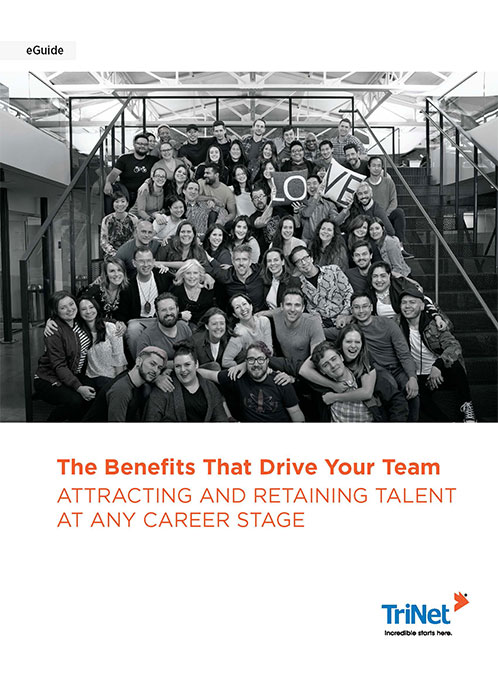
Table of contents
- 1.Download your eGuide.
- 2.Recruitment goals
- 3.Value over cost
- 4.Professional HR support
- 5.Download your eGuide.
In a tight labor market, more and more small and medium size businesses (SMBs) are realizing the importance of offering employee benefits, such as health insurance and retirement plans. There are many aspects to consider when offering employee benefits and an employee benefits professional can be instrumental in helping to design a plan that is right for your business. This post will focus on three main business areas businesses may want to consider when thinking about designing an employee benefits plan.

Download your eGuide.
Get our eGuide, The Benefits That Drive Your Team: Attracting and Retaining Top Talent at Any Career Stage, to learn what you can do to retain your valuable talent.
1. Recruitment goals
Employee benefits can be a positive contributor to a company’s ability to keep its top employees and compete for the type of talent that will drive success. It should come as no surprise that an employer’s compensation package—which includes their benefits offering—is one of the most important factors in a candidate’s decision to join the company. Another factor in recruiting top talent is company culture, which many employers may not realize is also affected by their employee benefits offering. Consider offering benefits that support initiatives you care about as a business, such as healthy living or work-life balance.
Here are some things to consider when creating a benefits package that contributes to the company culture and overall recruitment efforts:
• How are your benefits structured? Do employees have plenty of choices in selecting benefits that fit their lifestyle? Can they opt for an HMO or PPO? Can they choose between low and high-deductible plans?
• Do employees have the option of adding benefits that fit their family life, such as orthodontics, additional life insurance or pet insurance?
• Have you considered non-traditional benefits that align with your company values and contribute to the culture you want to create? These can include generous paid time-off, flexible scheduling, the ability to work remotely, employee assistance programs, gym and health club benefits, a budget for education and many other possible offerings.
2. Value over cost
Cost is, understandably, a key factor when determining the type and amount of employee benefits a company can provide. However, it is advisable to not make price the main driver when deciding what type of employee benefits to offer. The plans that are the lowest cost for you can often mean huge out-of-pocket expenses for your employees in the way of high deductibles, co-insurance, prescription drug costs and copays. It’s a good idea to look at the overall value of what you’re offering and not just the basic monthly costs.
Weigh the costs of offering more robust benefits with the return on investment that could result from happier, healthier employees and a potential boost to your recruitment efforts. As a small business competing with larger employers, you’ll want to weigh the value of being able to offer enterprise-level employee benefits that are created for smaller companies. While some applicants may find the culture and “family environment” of a small business attractive, it is hard for many candidates to sacrifice the benefits they receive from a large employer. Companies that can offer both are that much more attractive to job candidates.
One way a smaller business can offer employees access to a competitive benefits package is through a professional employer organization (PEO). A PEO can give SMBs access to the same benefits that their larger competitors enjoy. And this offering can usually be bundled as part of a comprehensive solution with other critical HR products and services.
While reviewing health plans, it’s good to keep in mind that some plans have a narrow or restricted network. These plans might seem more cost-effective but it’s at the cost of employees having limited choices of in-network physicians. Additionally, health insurers sometimes offer low initial pricing, only to give a substantial renewal increase the following year. This is why it’s important to read the fine print and be aware of all the costs employees could potentially absorb. It can also be helpful to review all insurance proposals with a benefits professional.
3. Professional HR support
Many SMBs find it helpful to have HR and benefits experts on their side who can help them design a benefits plan that fits their business goals, recruitment needs and budget. There are technology options out there that can certainly help provide benefits. However, an HR or benefits expert can help make sure the investment SMBs make in employee benefits will have the best return on investment. It can also be beneficial to make sure this person can help the entire team understand and enroll in these benefits. This helps minimize costly mistakes and improves compliance with employee benefits-related laws, such as the Affordable Care Act.
Employee benefits are a big part of a business’s investment in their workforce and it is a good idea to seek professional guidance in designing an effective plan that helps meet business goals.

Download your eGuide.
Get our eGuide, The Benefits That Drive Your Team: Attracting and Retaining Top Talent at Any Career Stage, to learn what you can do to retain your valuable talent.
This communication is for informational purposes only; it is not legal, tax or accounting advice; and is not an offer to sell, buy or procure insurance.

TriNet Team
Table of contents
- 1.Download your eGuide.
- 2.Recruitment goals
- 3.Value over cost
- 4.Professional HR support
- 5.Download your eGuide.





